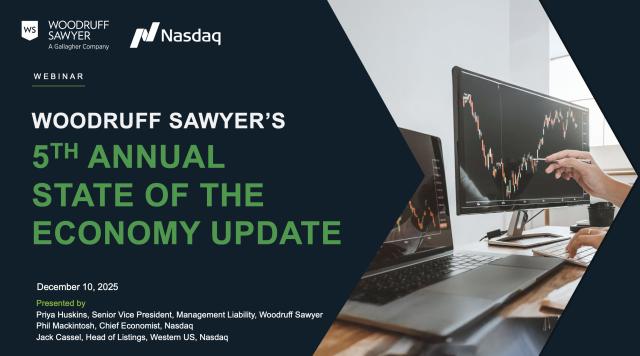Blog
Leveraging Advisory Boards: A Strategic Solution for Public Company Management Teams
Being asked to serve on an advisory board can be very flattering. But what exactly is an advisory board and are there traps for the unwary to avoid? In this week’s blog, my colleague Lenin Lopez discusses how advisory boards offer a flexible and cost-effective solution for companies to access top-tier expertise as well as issues potential advisory board members should consider before saying yes. –Priya
Public companies are under immense pressure to stay ahead of emerging trends, navigate increasingly complex regulations, and meet investor and other stakeholder demands. The expertise required to address these challenges is often specialized, hard to come by, and may not necessarily be needed in the long term. Hiring full-time employees with specialized expertise can be a lengthy and costly endeavor, often involving significant risks like cultural misalignment or the wrong strategic fit.

This is where an advisory board may help, offering a flexible and cost-effective solution to access top-tier expertise. However, while advisory boards can fill important knowledge gaps, they also come with their own set of risks that companies must carefully manage.
This article will:
- Briefly explain what an advisory board is
- Highlight reasons why some individuals may want to join an advisory board
- Discuss how advisory boards can help a company fill knowledge gaps
- Describe advisory board compensation structures
- Outline liability, indemnification, insurance, and other legal considerations
What Is an Advisory Board?
An advisory board is a group of experts assembled to provide strategic guidance and specialized knowledge to a company’s management team and in some cases, board of directors. Unlike a board, whose members are elected and have fiduciary responsibilities, advisory boards are appointed and typically focus on offering non-binding advice and recommendations on specific business challenges. Further, advisory boards do not generally have decision-making authority, allowing them to function with greater flexibility and conceivably less liability. We’ll get into that liability piece later.
The composition of an advisory board can vary significantly depending on the company’s needs. Members might include industry experts, academics, or current or former senior executives.
The size of advisory boards varies. Some include as few as three members, while others come in at more than 10. While a primary function of an advisory board is to enhance decision-making and/or drive growth by bringing in external perspectives and expertise, some advisory boards also include company executives.
Why Serve on an Advisory Board?
As noted by Korn Ferry in an article discussing advisory boards, “advisory boards provide executives with an outlet to gain visibility and make connections without the responsibility and commitment required of corporate board directors.” The article goes on to say that membership on an advisory board can help an individual expand their network, gain expertise, and ultimately create new professional opportunities, including being nominated for a board of director's position. Depending on the situation, advisory board members may also see serving as a way to gain knowledge from their advisory board peers. Also, it can be fun.
Filling Knowledge Gaps with Advisory Boards
As noted earlier, companies may face knowledge gaps that can negatively impact effective decision-making. For example, consider a company aiming to strengthen its environmental, social, and governance (ESG) initiatives in response to investor pressure and regulatory requirements. For most companies, hiring a group of individuals that are the ESG equivalent of the Avengers isn’t in the cards. However, by forming an ESG advisory board, the company can gain access to experts in sustainability, corporate governance, and social responsibility. These advisors can provide valuable insights into best practices, helping the company develop and implement effective ESG strategies.
Below are a few common examples of advisory boards that companies form:
- Technical (Scientific) Advisory Boards. These boards are composed of experts in specific technical fields, like artificial intelligence, biotechnology, or cybersecurity. They provide insights on emerging technologies, assess technical risks, and guide R&D initiatives. See here for a life science company’s announcement regarding the founding of a clinical advisory board; here for a pharmaceutical company’s announcement of a regulatory advisory board; and here for a technology company’s announcement related to its AI advisory board.
- Strategic Advisory Boards. These boards provide high-level strategic guidance on the overall direction of the company. Members typically include seasoned executives and strategic consultants who offer advice on corporate initiatives such as M&A, corporate restructuring, and long-term growth strategies. See here for a technology company’s announcement related to its global advisory board, which also refers to an advisory board it formed to support international growth.
- ESG Advisory Boards. With growing emphasis on sustainability and corporate responsibility, many companies are forming ESG advisory boards. As noted earlier, these boards bring together experts in sustainability, corporate governance, and social responsibility to help companies develop and execute their ESG strategies. See here for a healthcare company’s description of its ESG advisory board.
- DE&I Advisory Boards. As diversity, equity, and inclusion becomes increasingly important (or controversial), DE&I advisory boards can prove helpful in providing guidance on creating inclusive workplace environments, promoting diverse talent, and ensuring that DE&I initiatives are effectively implemented. See here for a cosmetic company’s description of its DE&I advisory board.
Each flavor of advisory board discussed above serves a particular purpose, but an underlying commonality is that membership is generally reserved for experts in their respective fields. For companies, this of course may beg the question: How much will an advisory board cost me? Let’s talk compensation.
Compensation of Advisory Board Members
Compensation, both amount and how it’s structured, can vary widely depending on the industry, level of expertise required, time commitment required, and scope of the advisory board’s responsibilities. While examples of compensation arrangements can be gleaned from publicly filed advisory board agreements, like this one or this one, it’s always a good idea to engage outside legal counsel or consultants that know the space.
For instance, DLA Piper published a short article that includes an example of what a typical advisory board member compensation package looks like, and the Advisory Board Centre published a survey stating that surveyed companies expected annual investment in an advisory board to be $40,000–$70,000. When you divide that amount by something like three to 10 people, it’s clear that we aren’t talking big dollars from either the company or individual advisory board member's perspective.
That said, common forms of compensation typically include one or a combination of the following:
- Cash Retainers. This can be an annual, quarterly, or other periodic cash retainer, which compensates advisory board members for their ongoing commitment to the company. This may be an attractive option if an advisory board meets or expects to meet on a regular basis.
- Per-Meeting Fees. Compensating advisory board members on a per-meeting basis may be an attractive alternative for companies over cash retainers, particularly when the advisory board isn’t expected to meet frequently.
- Equity Grants. Companies may decide to award equity grants or options to advisory board members. Like how equity grants made to employees are intended to align their financial interests with the long-term success of the company, the same general concept applies in the advisory board member setting. This approach may be a preferred approach for early-stage companies or companies that may not be cash-rich.
- Expense Reimbursement. At a minimum, companies will generally reimburse advisory board members for reasonable out-of-pocket expenses incurred in connection with their service.
Ultimately, if companies benchmark their compensation structures to ensure they are competitive and aligned with industry standards, they are likely to gain access to highly accomplished individuals they may not have access to otherwise.
Advisory Board Agreements: Liability, Indemnification, and Insurance Considerations
Advisory boards may not always be in a state of sunshine and rainbows. For example, the company may want to kick an advisory board member off the advisory board, advisory board members may become the subject of an investigation or litigation (e.g., conflict of interest issues), disputes may arise over what is expected of the advisory board, and wires may be crossed in terms of what is expected in compensation.
In that spirit, it’s important that the relationship between the company and advisory board members be memorialized in an advisory board agreement. For convenience, here are those examples: Senti Biosciences Scientific Board Advisory Board Agreement and Becton, Dickinson, and Company Advisory Board Consulting Agreement.
Outside legal counsel can ensure that these agreements are clearly drafted and align with the company’s expectations. As discussed below, it’s also important to consult with your insurance broker to ensure that insurance responds in the way the company expects it to.
Here are a few of the more critical topics that should ideally be addressed or discussed in the context of an advisory board agreement:
- Advisor/Consultant Relationship. Clearly define the advisory board member’s role as an advisor or consultant versus a director, officer, or employee. This distinction can limit liability exposure and clarify the advisory nature of their involvement. Misunderstandings here could inadvertently increase risk by subjecting advisory board members to fiduciary duties meant for the company’s board. For a discussion regarding the importance of this in the context of a case involving board observers, see this article from Winston & Strawn.
- Confidentiality/Insider Trading. In the course of their service on an advisory board, members will typically have access to confidential information related to the company and/or third parties. As a result, confidentiality provisions should ensure that this information is protected, prohibit insider trading, and include a process that clearly addresses what happens in the case of improper disclosure.
- Proprietary Rights. Intellectual property or proprietary information developed by advisory members should be addressed. In most cases, companies will retain the ownership of intellectual property that the advisory board member creates in the course of their service on the advisory board. This is especially important to include in the case of advisory board member agreements applicable to technical (scientific) advisory boards.
- Conflicts of Interest. Most advisory board members have day jobs or at least other positions that may create conflicts of interest. Advisory board member agreements should outline a procedure for disclosing potential conflicts and address how they will be handled to protect both the company and the advisory board member. It may be as simple as referencing the company’s code of conduct within the agreement. Ultimately, by including clear guidance, companies can help to avoid breaches of fiduciary duties and reputational damage.
- Attorney-Client Privilege. It’s important to remember that the presence of advisory board members in attorney-client privileged conversations that the company has with counsel may inadvertently waive that privilege. Not a good place for a company to find itself, especially in the context of litigation. Clarifying in advance which conversations, communications, and meetings are privileged will help to avoid introducing third parties, like advisory board members, that may cause the privilege to be waived.
-
Indemnification. While not all advisory board member agreements include indemnification provisions, the ones that do, like this one, generally state that the company will protect advisory board members against legal costs and liabilities that may arise from their service. For many individuals considering becoming an advisory board member, the lack of an indemnification provision in an advisory board member agreement will be a non-starter. Completely understandable.
Indeed, who would want the headaches of creating personal financial exposure without the benefit of the indemnification backstop? (Based on my review of several advisory board agreements, there are surprisingly some individuals who either don’t feel all that strongly about it or may not have an appreciation for the potential exposure.)
- Directors and Officers (D&O) Insurance. Non-employee advisory board members wouldn’t typically be covered by a company’s D&O insurance. While a company might choose to extend their D&O insurance coverage to include advisory board members, this would be unusual.
Consider first that advisory board members aren’t fiduciaries. At the edges, one might worry that extending D&O insurance coverage to an advisory board member may create a set of facts that may inadvertently chip away at the company’s position that the advisory board member is a consultant and not a fiduciary. More of a concern is one that arises for private companies. As a reminder, private company D&O insurance policies typically have an insured versus insured exclusion. The more people you name to the policy, the greater the chance this exclusion will be triggered. Another reason is advisory board members may be transient to some extent and may only serve for a short period. In that sense, why add additional insureds to your D&O policy that may negatively impact the total limits available to your directors and officers?
Parting Thoughts
As the challenges that companies face continue to grow in count and complexity, there continues to be a general need for experienced advisors, whether in the form of internal or external talent. As discussed above, for some companies, advisory boards may be an attractive alternative to onboarding full-time experts or even recruiting new directors to the board.
Having said that, for the reasons discussed in this article, venturing into the world of forming an advisory board should be done with some caution and advice of counsel to avoid traps and unmet expectations.
Author
Table of Contents











